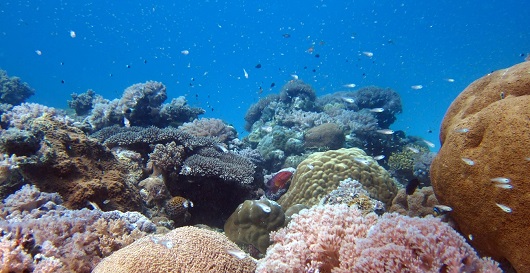Research helps support Indian Ocean sanctuary

Research by scientists at the University of St Andrews, published today in PLOS One, proves that the Vamizi Island marine sanctuary, in the north of Mozambique, has had a positive effect on fish populations not only within the reserve but also in the surrounding area.
Vamizi and the surrounding islands represent one of the world’s most important regions of bio-diversity, with over 180 different species of coral and more than 400 species of reef fish recorded to date.
Until recently these precious resources were under threat from Tanzanian fishing companies, and fishermen from Nampula, that had destroyed their own fishing sites with dynamite fishing. That was until six years ago when the Vamizi Island sanctuary was established by the local Fisheries Council (CCP) in recognition of the international value of the Vamizi ecosystem and its importance to the livelihoods of local communities.
The Marine Sanctuary extends three kilometres out to sea around the eastern side of the island and represents a ‘no-take’ fishing zone. It is policed by the CCP and represents one of the only working models of conservation through community, government and tourism cooperation in Mozambique.
This project has been a challenge, and has required dialogue and negotiation between villagers, the CCP, marine biologists, and the tourist industry. The will to listen and to compromise, on all sides, has been essential and it has long been accepted that the sustainability of many of these compromises would rely on evidence of success.
The research published today will provide some of that evidence, and should help to support a long-term future for this collaborative development which has already allowed tourists access to an almost untouched environment, villagers access to more jobs, medicines, better schools, a new health centre, easier access and communications.
Report co-author, PhD student Isabel Silva, said:
“Usually, when ecologists go to the field and propose solutions to a specific problem these aren’t well accepted by the local inhabitants. It’s easy to arrive and set rules that will save the world in the long term, but that make the present lives of those who live on site more difficult. This can be even more dramatically unfair if you think that very often the people who set the rules have always lived in abundance and will go back to their comfortable lives, while those on whom the rules are imposed have to struggle for survival every single day of their lives.
“For once this is apparently not true. On Vamizi Island investors and ecologists have joined forces with a local community longing for development: and together they found a win/win solution.”
Data collected over the past six years shows that not only are there, as expected, more and bigger fish within the reserve, but also that the sanctuary has had a spillover effect outside its limits – thus improving the quality of the fishing available for the villagers.
The spillover effect is evident in herbivorous fish, such as parrot fish, but not yet detected in piscivorous fish such as groupers and brasses.
It was also established that the fish that swim out of the protected area and are caught by the fishermen are smaller than the ones that stay within the boundaries of the sanctuary, although they are bigger than the fish found in areas further from the sanctuary.
Co-author Dr Maria Dornelas, of the University of St Andrews School of Biology, concluded:
“This study proves that small community managed sanctuaries, respected by the whole community, have a positive effect on the fish population of nearby areas. However, these effects are not immediate and may happen only for some species. As such, it is advisable to propose immediate incentives to the communities to justify closing some areas to fishing.”
Notes to news editors
The paper is available to view at: http://journals.plos.org/plosone/article?id=10.1371/journal.pone.0111774
Isabel Silva is available for interview on 01334 46 2530
Photos are available on request from the Press Office. Contact 01334 462 108
Category Research